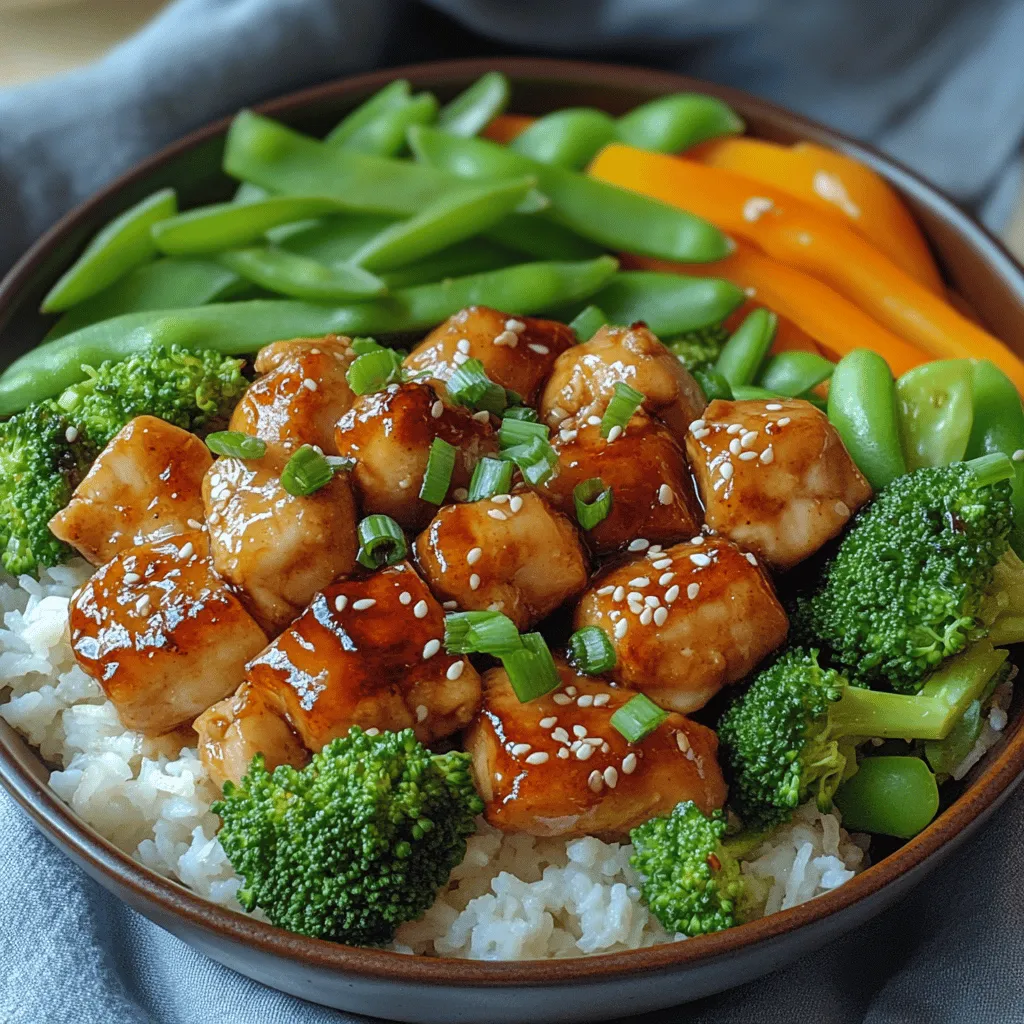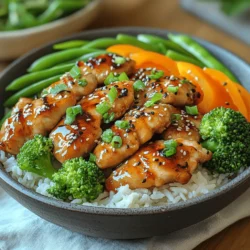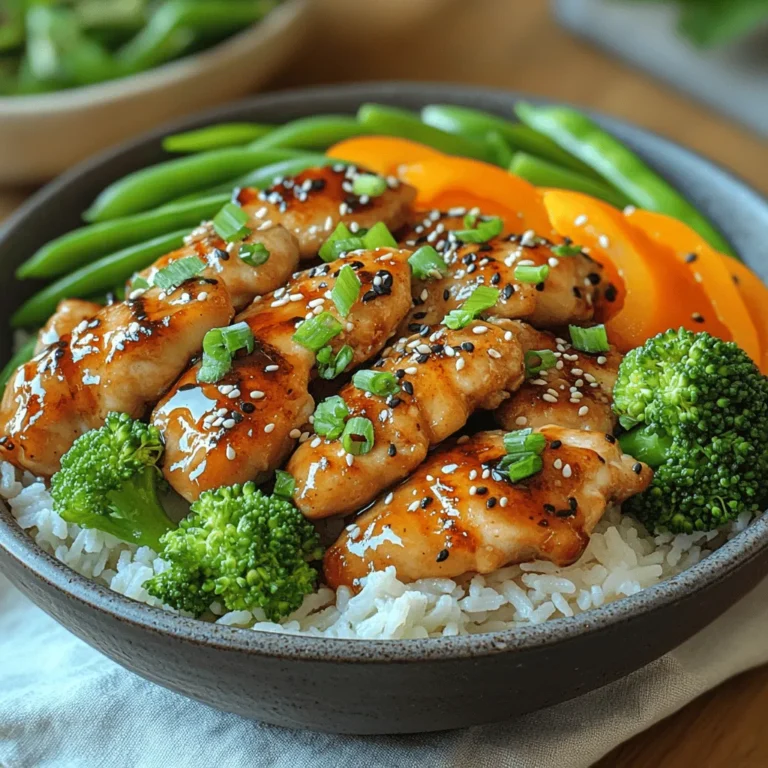Teriyaki chicken bowls have surged in popularity as a go-to meal for those seeking a quick, nutritious, and delicious option. These bowls are not only packed with flavor but also provide a balanced meal that fits perfectly into the fast-paced lifestyle many of us lead today. With tender chicken, vibrant vegetables, and a savory-sweet sauce, this dish is a delightful fusion of taste and nutrition.
Ingredients
– 1 pound boneless, skinless chicken thighs
– 2 cups broccoli florets
– 1 bell pepper, sliced (any color)
– 1 cup snap peas
– 2 cups cooked rice (white or brown)
– ½ cup teriyaki sauce
– 1 tablespoon sesame oil
– 2 cloves garlic, minced
– 1 tablespoon fresh ginger, minced
– Optional toppings: sliced green onions, sesame seeds
Instructions
1. Start by marinating the chicken thighs in teriyaki sauce for at least 30 minutes, preferably longer for more flavor.
2. In a large skillet or wok, heat sesame oil over medium-high heat.
3. Add the minced garlic and ginger, sautéing until fragrant, about 1 minute.
4. Remove the chicken from the marinade (reserve the marinade) and add the chicken thighs to the skillet. Cook for 5-7 minutes on each side, or until the chicken is browned and cooked through.
5. While the chicken is cooking, prepare the vegetables. Add the broccoli, bell peppers, and snap peas to the skillet during the last 3-4 minutes of cooking. Stir-fry until the vegetables are tender but still crisp.
6. Pour the reserved teriyaki marinade over the chicken and vegetables, allowing it to simmer for an additional 2-3 minutes to thicken slightly.
7. Serve the teriyaki chicken and vegetables over a bed of cooked rice, and garnish with sliced green onions and sesame seeds if desired.
Understanding Teriyaki: A Brief Culinary History
Teriyaki sauce has its roots in Japanese cuisine, where it was traditionally used to glaze grilled fish and meat. The term “teriyaki” itself refers to the cooking technique of grilling or broiling food with a glaze, which often includes soy sauce, sugar, and mirin. Over time, this technique has evolved, and variations of teriyaki can now be found in cuisines around the world, each bringing its unique twist to the classic flavors.
Ingredients Breakdown: Fresh and Flavorful Components
To create the perfect teriyaki chicken bowl, understanding the ingredients is crucial.
– Boneless, Skinless Chicken Thighs: Using chicken thighs instead of breasts adds more flavor and moisture to the dish. Thighs are also generally more forgiving when cooked, making them ideal for quick meals.
– Fresh Vegetables: Incorporating a variety of vegetables like broccoli, bell peppers, and snap peas not only adds color to the dish but also boosts its nutritional value. These vegetables are rich in vitamins and minerals, contributing to a well-rounded meal.
– Rice Options: The choice of rice can influence the dish’s overall health profile. Brown rice offers more fiber and nutrients compared to white rice, making it a healthier option for those looking to enhance their diet.
A Spotlight on the Teriyaki Sauce Ingredients:
– Soy Sauce: Opting for low-sodium soy sauce can help reduce sodium intake while still providing that essential umami flavor.
– Honey: This natural sweetener not only enhances the flavor of the sauce but also offers health benefits compared to refined sugars.
– Rice Vinegar: This ingredient adds a tangy note to the sauce, balancing the sweetness and enhancing the overall flavor.
– Sesame Oil, Garlic, and Ginger: These aromatics are key to elevating the dish, adding depth and complexity to the teriyaki flavor profile.
By understanding the components that make up this dish, you can appreciate the careful balance of flavors and nutrition in your teriyaki chicken bowl.

Preparing the Rice
Cooking Methods for Perfect Rice
Cooking rice can be simple, but achieving the perfect texture requires attention to detail. For fluffy rice, consider using the absorption method, where you cook the rice in water until it is fully absorbed. Rinse the rice before cooking to remove excess starch, which can make it sticky. For added flavor, you might cook the rice in chicken broth instead of water. The ratio is typically 1 cup of rice to 1.5 cups of liquid.
Tips for Perfect Rice
– Use a heavy-bottomed pot for even heat distribution.
– Allow the rice to rest covered for about 10 minutes after cooking to let it steam and settle.
– Fluff the rice with a fork instead of stirring with a spoon to maintain its texture.
Sautéing the Chicken
Techniques for Achieving Perfectly Cooked Chicken
To get juicy, flavorful chicken pieces, start with chicken thighs or breasts cut into uniform pieces to ensure even cooking. Heat your pan until it’s hot before adding the chicken to achieve a good sear. Avoid overcrowding the pan, as this can lower the temperature and cause steaming instead of sautéing.
Tips for Cooking Chicken
– Season the chicken lightly with salt and pepper before adding it to the pan.
– Allow the chicken to brown on one side before flipping to develop a rich flavor.
– Use a meat thermometer to check for doneness; the internal temperature should reach 165°F (75°C).
Making the Teriyaki Sauce
Whisking Technique and Flavor Balance
A good teriyaki sauce is the heart of your chicken bowls. Start with soy sauce, mirin, and sugar as your base. To achieve a balanced flavor, whisk these ingredients together until the sugar dissolves completely. For additional depth, consider adding minced garlic or ginger.
Tips for Perfect Sauce
– Simmer the sauce for a few minutes to thicken it slightly.
– Taste the sauce as you go; adjusting with more sugar for sweetness or soy sauce for saltiness can help achieve your preferred flavor.
– If the sauce becomes too thick, add a splash of water to reach your desired consistency.
Incorporating Vegetables
Timing and Cooking Tips
To get the best texture and flavor from your vegetables, it’s important to add them at the right time. Start with heartier vegetables like bell peppers or carrots, which take longer to cook, followed by quicker-cooking options like snap peas or broccoli.
Tips for Cooking Vegetables
– Cut vegetables into uniform sizes for even cooking.
– Sauté them in the same pan after cooking the chicken to absorb the leftover flavors.
– Avoid overcooking; aim for vibrant colors and a slight crunch to retain nutrients.
Assembling the Bowls
Presenting the Dish Attractively
When it comes to assembly, presentation can elevate your meal. Begin with a base of fluffy rice, then layer the sautéed chicken and vegetables on top. Drizzle the teriyaki sauce over the entire bowl, and consider garnishing with sesame seeds or chopped green onions for a pop of color.
Nutritional Benefits of Teriyaki Chicken Bowls
Overview of the Dish’s Nutritional Profile
Teriyaki chicken bowls are not only delicious but also packed with nutrients. They offer a balanced meal with lean protein, a variety of vegetables, and wholesome carbs from the rice.
Health Benefits of Lean Protein and Vegetables
The chicken provides essential amino acids, while the vegetables contribute vitamins and minerals vital for overall health. Incorporating a mix of colorful vegetables can enhance the meal’s antioxidant properties.
Caloric Content and Portion Control
A typical serving of teriyaki chicken bowls can range from 400 to 600 calories, depending on portion sizes and ingredients. Adjusting the amount of rice or sauce can help maintain portion control while still enjoying a hearty meal.
Tips for Customizing Your Teriyaki Chicken Bowls
Suggestions for Protein Substitutions
For those looking to switch things up, tofu is an excellent vegetarian alternative, while shrimp or beef can provide different textures and flavors. Adjust cooking times according to the protein you choose.
Alternative Vegetables
Consider adding vegetables like zucchini, mushrooms, or bok choy, which pair well with teriyaki sauce. Feel free to experiment with seasonal options for variety.
Adjusting Sauce Sweetness and Saltiness
If you prefer a sweeter sauce, add more sugar or honey. For a saltier profile, a splash of soy sauce can enhance flavor without overpowering the dish.
Serving Suggestions and Pairings
Ideas for Side Dishes
Complement your teriyaki chicken bowls with simple side dishes like steamed edamame, a fresh green salad, or miso soup to round out the meal.
Beverage Pairings
Pair your meal with light beverages such as green tea, sparkling water, or a crisp white wine to enhance the dining experience.
Creative Ways to Serve Leftovers
Leftover teriyaki chicken can be repurposed into wraps, sandwiches, or salads for a quick lunch. Alternatively, consider making a fried rice or stir-fry dish to enjoy the flavors anew.
Conclusion
Making teriyaki chicken bowls at home is not only easy but also allows you to explore a variety of flavors and ingredients to suit your preferences. This versatile recipe is perfect for busy weeknights or casual gatherings, inviting creativity and personal touches. Try your hand at this delightful dish and enjoy the satisfaction of crafting a meal that is both quick and flavorful.


